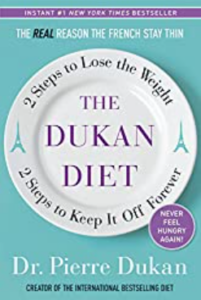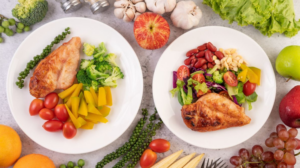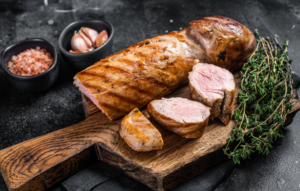An In-Depth Look into the 4 Phases of the Dukan Diet 90-95% of people who lose weight gain it back within 12 months, which is an awfully large number of the dieting population. This is why various diet programs began to arise and have steadily risen over the past couple of decades including what is known as the Dukan Diet. They are intended to assist with permanent weight loss over a short period of time, but there are certain programs that you should consider trying first to save yourself any wasted time and money.
The Dukan Diet
This is one of the top diets that have been proven to work for thousands of people across the world.  The Dukan Diet was originally created for an obese patient who responded poorly to the common low-calorie diet since he wanted to consume meat, so a French doctor named Pierre Dukan came up with a solution. Eat a high amount of protein and minimize the consumption of fats and carbohydrates for specific periods, which comes from the following 4 different phases that are described below. These phases are broken down into specific instructions that took 20 years to develop before the information was released.
The Dukan Diet was originally created for an obese patient who responded poorly to the common low-calorie diet since he wanted to consume meat, so a French doctor named Pierre Dukan came up with a solution. Eat a high amount of protein and minimize the consumption of fats and carbohydrates for specific periods, which comes from the following 4 different phases that are described below. These phases are broken down into specific instructions that took 20 years to develop before the information was released.
1) The Attack Phase
People who have already followed the Dukan Diet agree that the Attack Phase is the hardest stage in this diet regimen. You will be focusing on taking away most carbohydrates and fats from your diet for as long as seven days, but most people fall within the timeline of 2-to 5 days. This means you are only allowed to consume 68 chosen foods that are high in protein. This enables the fat-burning process while also allowing you to keep your muscles and bones healthy and strong.
Your body does need all three macronutrients to survive and properly support life, which is why this phase is not very long at all. The purpose is for your body to start using body fat to produce energy instead of glucose (sugar) that is received through carbs, which is called being in a ketogenic state. This is similar to the low-carb diet since it places you in this state of ketosis, but the difference is a low amount of fats being consumed as well to prevent them from replacing what has been taken away.
Proteins that are generally allowed to be consumed within the attack phase of the Dukan diet are lean meats/poultry, eggs, low-fat dairy, and tofu. Examples of these meats and poultry would be lean cuts of beef and pork; turkey and chicken that are skinless; and certain fish as well. However, oat bran is a daily requirement and is also included in the diet by consuming 1 ½ tablespoons each day.
Exercise also plays a factor in the attack phase since you need to encourage your muscles to use the excess fat for energy consumption. You could perform a mixture of strength training and cardio if you wish, but for those not very advanced in exercising this could be a problem. Once you start on a diet that requires low carbohydrate consumption your body begins to go uneasy and dizziness may occur. For this reason, most people perform a brisk 20-minute walk as their exercise plan.
The average amount of weight to be lost is around 2-8 in a week, which is sometimes looked at as too much for one week, but the reason it is not too bad is that it only lasts for a short amount of time and you are giving your body nutrients.
2) The Cruise Phase
The second phase of the Dukan Diet allows you to add vegetables to your diet program that took them away during the attack phase, but you are still following strict limitations on the types of vegetables that you consume, and it is not for every day of the cruise phase. The way this phase works is pretty simple. You can choose up to 5 equal days for protein only and then days with vegetables added in.
during the attack phase, but you are still following strict limitations on the types of vegetables that you consume, and it is not for every day of the cruise phase. The way this phase works is pretty simple. You can choose up to 5 equal days for protein only and then days with vegetables added in.
For example, if you choose 3 straight days of protein only, then you follow those days with 3 allowing vegetables. However, although a 5/5 equal ratio of days is the best for fast burning, the most common method people use is the 1/1 equal ratio, which is alternating each day with protein to protein and vegetable. This second phase of the Dukan Diet is going to last until you reach a true weight that fits your height and body mass index (BMI) standards.
People who are obese have different ways to calculate this that the Dukan Diet provides for the program since going below a certain point would actually do more harm than good. A large drop in weight in just the second phase alone is putting an obese individual at risk of gaining the fat back even faster during this next phase to be discussed.
Oat bran is still a daily requirement, but the serving has been increased to 2 tablespoons each day. Then exercising times are to be increased by 10 minutes now, which would make them need to last at least 30 minutes. This is the time of the diet that most people consider increasing their strength training and cardio since carbs from vegetables are curving some of the dizziness and headaches due to a low amount of carbs being consumed.
The average amount of weight to be lost is 2 pounds per week until you reach your true weight goal.
3) The Consolidation Phase
The consolidation phase would appear to be an easier portion of the diet, but a lot of willpower is going to be required since more carbohydrates are going to be allowed within the diet along with fats and starches. This phase actually lasts the longest compared to the other 3 phases since it is 5 days of the consolidation phase per pound lost during the cruise phase. For example, 25 pounds of weight being lost during phase 2 = 125 days for phase 3, which would total over 4 more months of dedicated, well-enforced dieting.
The purpose of this phase is to prevent weight gain from coming back since you are now able to work your way back into eating regular foods again, but the foods are healthy ones for the most part. The breakdown of the consolidation phase goes like this:
The Consolidation Phase

1 day of pure protein only each week on the same day every week following. Thursdays are the recommended day by the program.
5 of the days are the protein and vegetables that were allowed during phase two, but fruits, cheese, and 100% slices of whole wheat bread are added in.
One serving of starches is allowed each week on a day of your choosing except the protein-only day.
Up to two servings of lamb, ham, or roast pork are allowed each week.
One celebration meal of anything you choose, but no seconds are allowed.
As you can see there are a lot of extra foods being allowed into your diet making it feel like a reward after a pretty difficult start for dieting. Even a celebration day is allowed each week, which is commonly referred to as a “cheat” day by bodybuilders.
However, this is the first half of the consolidation phase. There is actually a second half where only a few things change. These changes are having 2 celebration meals and 2 servings of starchy foods such as rice or potatoes, but you cannot have both in a row. For example, you can have a celebration meal for one day, and the next day a serving of starches, but not another celebration meal.
4) Permanent Stabilization Phase

You have completed the Dukan Diet and now are able to go into the permanent stabilization phase, which is when you live the rest of your life following three simple rules when it comes to weight maintenance.
1. Pure protein every Thursday
2. 3 tablespoons of oat bran every day
3. No using escalators or elevators unless you go up more than five stories
The third rule applies to the concept that you should use as many calories each day as possible, but in small amounts, so you do not have to train for an hour each day (unless you want to). Basically, you are trying to keep weight gain away from your body.
Sometimes you may need to eat different foods if you have added too many “celebratory” meals in since you are just going back down the path to gaining fat again. Common sense is to be used on what foods you eat too much such as sweets and greasy foods. People often make the mistake that their diet program has ended so they can just go back to the way they were before. Do not make this mistake and maintain a healthy eating lifestyle with exercise at least 4-5 days a week!
Extra Information for All Phases of the Dukan Diet

This article is by no means comprehensive and if you are interested or need more information about the Dukan Diet, your best bet is to go to the source.
There are other details that you should be aware of that are not always given by a lot of resources such as water consumption. The reason is probably because this should be something everyone does, but regardless of the reason, you should be consuming at least 1 ½ quarts of water daily. Alcohol is a liquid full of empty calories and is not allowed until the final phase of the Dukan Diet, and even then it is limited to one serving a day.
Salt, or sodium, is also not covered very much, but is to be limited as well. Salt causes water retention that leads to swelling and rapid fat gains, plus it is not good for your blood pressure or heart as well. A small amount of salt being used for taste is okay.
Phases of the Dukan Diet Conclusion
The Dukan Diet as you can see is not the easiest weight loss program available to you, but the reason is because it actually helps a lot of people with achieving their goals. You can always perform the minimum amount of days for the attack phase (2-3 days) if you feel the pure protein-only phase is too difficult, which is understandable by the creator who researched ways to give you the best results possible.
However, the second and third phases have a much longer duration and are to be followed very specifically since now you have some more food being allowed to eat. The Dukan Diet has the full list of foods available to be eaten during each phase, which could not be fully covered since there are over 100 of them for you to choose from.
As mentioned previously, the fourth and final phase of the Dukan Diet needs to be performed with caution for basically the rest of your life. You can easily get back into bad habits since you are allowed to freely consume most foods again, so you are encouraged to stay away from drinking too many empty calories (alcohol, soda, sweetened fruit juice) and eating junk food again to prevent losing all the hard work you put into the diet program.

